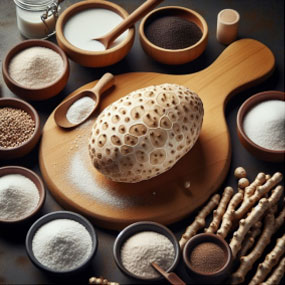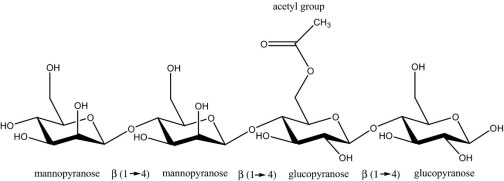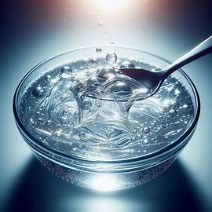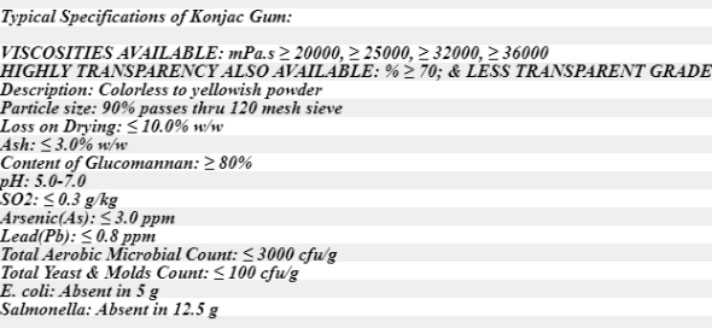Konjac (INS 425), comprises of konjac gum (INS 425 i) and konjac glucomannan (INS 425 ii) when used as food additives. Konjac gum (INS 425 i) and Konjac glucomannan (INS 425 ii) are defined as water soluble hydrocolloid obtained from konjac flour & are distinguished by their grade & purity. Konjac gum is obtained by aqueous extraction, while konjac glucomannan is obtained by washing with water-containing ethanol.
Konjac flour is defined as the unpurified raw product from the tuber of the perennial plant Amorphophallus konjac.
Its main component is a high-molecular-weight polysaccharide glucomannan which consists of d-mannose and d-glucose units at a molar ratio of 1.6:1.0, connected by β(1-4)-glycosidic bonds. Further in the definition of glucomannan from konjac gum is stated that shorter side chains are attached through β(1-3)-glycosidic bonds, and acetyl groups occur at random at a ratio of about 1 group per 9–19 sugar units, while in the definition of konjac glucomannan it is said that branching occur at about each 50th or 60th unit and that about each 19th sugar residue is acetylated.

Konjac Gum
The CAS registry number 37220-17-0 and the EINECS No 253-404-6 correspond to konjac mannan, a term that covers for both konjac gum and konjac glucomannan. Konjac gum (INS 425 i) and konjac glucomannan (INS 425 ii) are distinguished in the definition regarding the main components (≥ 75% carbohydrate vs ≥ 95% total dietary fibre on a dry weight basis) and in molecular weight.
The average molecular weight of the polysaccharide in konjac gum is in the range of 200,000–2,000,000 and in konjac glucomannan 500,000–2,000,000. The indication of the molecular weight covers a larger range down to 200,000 for konjac gum as compared to konjac glucomannan.
Concerning impurities, konjac gum and konjac glucomannan differ in the maximum permitted content of proteins (N × 5.7) (≤ 3% vs ≤ 1.5%), starch (≤ 3% vs ≤ 1.5%), inorganic substances (total ash) (≤ 5% vs ≤ 2%) and contaminants such as lead (≤ 2% vs ≤ 1%), as well as in physical properties such as solubility and viscosity in 1% solution.
The glucomannan from konjac gum and from konjac glucomannan is composed of linear chains of (1→4)-linked mannopyranose and glucopyranose units with varying amounts of acetyl groups. The degree of acetyl groups distribution in the konjac gum is reported to be at a ratio of about 1 group per 9–19 sugar units.
The degree of acetyl groups distribution in the konjac glucomannan is reported to be lower at about 19th sugar residue.
As regards the konjac gum, shorter polysaccharide side-chains are attached to the C6 of glucosyl units of the backbone, while according to EU Regulations, the branching point is at the position 3.
The structural formula of the repeating unit of konjac glucomannan.

Konjac gum, also known as glucomannan, is primarily composed of two polysaccharides: glucomannan and galactomannan. These polysaccharides are the main components responsible for its unique properties and health benefits.
Glucomannan: Glucomannan is a water-soluble dietary fiber consisting primarily of glucose and mannose units. It is the main component of konjac gum and contributes to its ability to absorb water and form a gel-like substance.
Galactomannan: Galactomannan is another type of polysaccharide found in konjac gum. It is composed of galactose and mannose units and contributes to the thickening properties of konjac gum.
In addition to these polysaccharides, konjac gum may also contain other minor components such as protein, starch, and minerals, although these are present in smaller quantities compared to the main polysaccharides.
The exact chemical composition of konjac gum can vary depending on factors such as the source of the konjac plant and the processing methods used to extract the gum. However, glucomannan and galactomannan are the key components responsible for its functional and nutritional properties.
Konjac gum (INS 425 i) is a white to cream to light tan powder, while konjac glucomannan (INS 425 ii) is a white to slightly brownish fine particle size, free flowing and odourless powder. Both konjac gum and konjac glucomannan are dispersible in hot or cold water forming a highly viscous solution. Solubility increases with heat and speed of agitation. pH values of the solutions of konjac gum and glucomannan are in the ranges of 4.0–7.0 and 5.0–7.0, respectively. Depending on purity, they absorb water up to 200 times of their weight. The glucomannan forms viscous, pseudoplastic dispersions. Viscosity of 1% solutions at 35°C were estimated to be in the range between 13.5 and 18.0 mPa·s. An important property of konjac gum, konjac glucomannan and konjac flour in water is the physicochemical interaction with xanthan gum, kappa-carrageenan and agar causing a synergistic increase in viscosity.
When konjac gum (INS 425 i) and konjac glucomannan (INS 425 ii) is added in combination with other gums, such as xanthan gum (INS 415), agar (INS 406) or carrageenan (INS 407), there is synergistic increase in viscosity.
The differences between the konjac gum (INS 425 i) and the konjac glucomannan (INS 425 ii) are based on molecular weight distributions, different degrees of acetylation & different contents of impurity in the konjac gum, leading to different physicochemical properties. This might be due to the use of different solvents to prepare the food additives.
Konjac gum being a natural plant-based hydrocolloid it contains high water-soluble edible fibres, minerals, trace elements & 16 types of amino acids.
The in vitro degradation and the in vivo digestibility of konjac glucomannan in animals has demonstrated that this compound would not be absorbed intact or hydrolysed by digestive enzymes. Konjac glucomannan and konjac flour can be regarded as non-toxic based on the results of acute oral toxicity studies.

Transparent viscous gel

Noodles, jams, jellies, pasta

Bread, jams, cakes, icecreams
| Konjac Gum (INS 425 i) | Konjac glucomannan (INS 425 ii) | Konjac flour (INS 425) | |
|---|---|---|---|
| Definition | Konjac gum is a water-soluble hydrocolloid obtained from the konjac flour by aqueous extraction. Konjac flour is the unpurified raw product from the root of the perennial plant Amorphophallus konjac. The main component of konjac gum is the water-soluble high-molecular-weight polysaccharide glucomannan, which consists of d-mannose and d-glucose units at a molar ratio of 1,6:1,0, connected by β(1-4)-glycosidic bonds. Shorter side chains are attached through β(1-3)-glycosidic bonds, and acetyl groups occur at random at a ratio of about 1 group per 9–19 sugar units | Konjac glucomannan is a water-soluble hydrocolloid obtained from konjac flour by washing with water-containing ethanol. Konjac flour is the unpurified raw product from the tuber of the perennial plant Amorphophallus konjac. The main component is the water-soluble high-molecular-weight polysaccharide glucomannan, which consists of d-mannose and d-glucose units at a molar ratio of 1,6:1,0, connected by β(1-4)-glycosidic bonds with a branch at about each 50th or 60th unit. About each 19th sugar residue is acetylated | The hydrocolloidal polysaccharide obtained from the tubers of various species of Amorphophallus; principal component is a high-molecular-weight, slightly branched, non-ionic glucomannan consisting of mannose and glucose, connected by β-1,4 linkages, at a respective molar ratio of approximately 1.6-4:1; acetyl groups along the glucomannan back-bone contribute to solubility properties and are located, on average, every 9–19 sugar units |
| Molecular weight | The main component, glucomannan, has an average molecular weight of 200,000–2,000,000 | 500,000–2,000,000 | The main component, glucomannan, has an average molecular weight of 200,000–2,000,000 |
| Assay | Not less than 75% carbohydrate | Total dietary fibre: not less than 95% on a dry weight basis | Not less than 75% carbohydrate. The remainder, after subtracting from 100% the sum of the percentages of total ash, loss on drying and protein, represents the percentage of carbohydrate (glucomannans) in the sample |
| Description | A white to cream to light tan powder | White to slightly brownish fine particle size, free flowing and odourless powder | White or cream to light tan powder |
| Solubility | Dispersible in hot or cold water forming a highly viscous solution with a pH between 4.0 and 7.0 | Dispersible in hot or cold water forming a highly viscous solution with a pH between 5.0 and 7.0. Solubility is increased by heat and mechanical agitation | Dispersible in hot or cold water forming a highly viscous solution with a pH between 4.0 and 7.0 Solubility is increased by heat and mechanical agitation. Addition of mild alkali to the solution results in the formation of a heat-stable gel that resists melting, even under extended heating conditions |
| Konjac Gum (INS 425 i) | Konjac glucomannan (INS 425 ii) | Konjac flour (INS 425) | |
|---|---|---|---|
| Gel formation | Add 5 mL of a 4% sodium borate solution to a 1% solution of the sample in a test tube & shake vigorously. A gel forms | - | Add 5 mL of a 4% sodium borate solution to a 1% solution of the sample in a test tube & shake vigorously. A gel forms. |
| Formation of heat-stable gel | Prepare a 2% solution of the sample by heating it in a boiling water bath for 30 min, with continuous agitation and then cooling the solution to room temperature. For each gram of the sample used to prepare 30 g of the 2% solution, add 1 mL of 10% potassium carbonate solution to the fully hydrated sample at ambient temperature. Heat the mixture in a water bath to 85°C & maintain for 2 h without agitation. Under these conditions, a thermally stable gel is formed | Prepare a 2% solution of the sample by heating it in a boiling water bath for 30 min, with continuous agitation and then cooling the solution to room temperature. For each gram of the sample used to prepare 30 g of the 2% solution, add 1 mL of 10% potassium carbonate solution to the fully hydrated sample at ambient temperature. Heat the mixture in a water bath to 85°C & maintain for 2 h without agitation. Under these conditions a thermally stable gel is formed | Prepare a 2% solution of the sample by heating it in a boiling water bath for 30 min, with continuous agitation and then cooling the solution to room temperature. For each gram of the sample used to prepare the 2% solution, add 1 mL of 10% potassium carbonate solution to the fully hydrated sample at ambient temperature. Heat the mixture in a water bath to 85°C and maintain for 2 h without agitation. Under these conditions, a thermally stable gel is formed. Related hydrocolloids such as guar gum and locust bean gum do not form thermally stable gels and are negative by this test |
| Loss on drying | Not more than 12 % (105°C, 5 h) | Not more than 8% (105°C, 3 h) | Not more than 15% (105°, 5 h) |
| Starch | Not more than 3% | Not more than 1% | - |
| Protein | Not more than 3% (N × 5.7) | Not more than 1.5% (N × 5.7) Determine nitrogen by the Kjeldahl method. The percentage of nitrogen in the sample multiplied by 5.7 gives the percent of protein in the sample | Not more than 8% Nitrogen Determination (Kjeldahl method). The percentage of nitrogen in the sample multiplied by 5.7 gives the percent of protein in the sample |
| Viscosity (1% solution) | Not less than 3 kg/m·s at 25°C | Not less than 20 kg/m s at 25°C | - |
| Ether-soluble material | Not more than 0.1% | Not more than 0.5% | - |
| Sulphite (as SO2) | - | Not more than 4 mg/kg | - |
| Chloride | - | Not more than 0.02% | - |
| 50% Alcohol-soluble material | Not more than 2.0% | ||
| Konjac Gum (INS 425 i) | Konjac glucomannan (INS 425 ii) | Konjac flour (INS 425) | |
| Total ash | Not more than 5.0% (800°C, 3–4 h) | Not more than 2.0% (800°C, 3-4 h) | Not more than 5% (800°, 3–4 h) |
| Arsenic | Not more than 3 mg/kg | - | - |
| Lead | Not more than 2 mg/kg | Not more than 1 mg/kg | - |
| Salmonella spp. | Absent in 12.5 g | Absent in 12.5 g | – |
| Escherichia coli | Absent in 5 g | Absent in 5 g | – |
